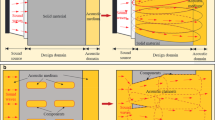Abstract
Problems with regard to the optimized design of structure-borne acoustic radiation in the intermediate-frequency region were first studied in this paper. The multi-objective optimization model was established based on structural dynamic response equation and acoustic radiation equation. Acoustic vibration analysis of cavity structural model was conducted to determine intra-cavity noise sources under different random excitation conditions, and then appropriate design variables were selected. Results indicated that after structural size optimization under different excitation conditions, the intra-cavity sound pressure levels lowered to a certain degree. Particularly in the low-frequency region, the maximum decreasing amplitude of sound pressure level could reach 5–7 dB, and the acoustic performance of cavity structure improved favourably.





Similar content being viewed by others
References
Droz, C., Zergoune, Z., Boukadia, R., Bareille, O., et al. (2016). Vibro-acoustic optimization of sandwich panels using the wave/finite element method. Composite Structures, 156, 108–114.
Wadbro, E., & Berggren, M. (2006). Topology optimization of an acoustic horn. Computer Methods in Applied Mechanics and Engineering, 2006(196), 420–436.
Denli, H., & Sun, J. Q. (2007). Structural-acoustic optimization of sandwich structures with cellular cores for minimum sound radiation. Journal of Sound and Vibration, 301, 93–105.
Goo, S., Wang, S. Y., Kook, J., et al. (2017). Topology optimization of bounded acoustic problems using the hybrid finite element-wave based method. Computer Methods in Applied Mechanics and Engineering, 313, 834–856.
Wang, X. J., Li, Y. L., Ma, Z. L., et al. (2017). Robust optimization of structural-acoustic coupled system with random parameters. Aerospace Science and Technology, 60, 48–57.
Chen, L. Y., & Zhang, Y. F. (2013). A study on the application of material selection optimization approach for structural-acoustic optimization. Materials and Design, 52, 207–213.
Isakari, H., Kondo, T., Takahashi, T., et al. (2017). A level-set-based topology optimisation for acoustic–elastic coupled problems with a fast BEM-FEM solver. Computer Methods in Applied Mechanics and Engineering, 315, 501–521.
D’Amico, R., Neher, J., Wender, B., et al. (2012). On the improvement of the solution accuracy for exterior acoustic problems with BEM and FMBEM. Engineering Analysis with Boundary Elements, 36(7), 1104–1115.
Shorter, P. J., & Langley, R. S. (2005). On the reciprocity relationship between direct field radiation and diffuse reverberant loading. Journal of the Acoustical Society of America, 117(1), 85–95.
Reynder, E., Langley, R. S., & Dijckmans, A. (2014). A hybrid finite element-statistical energy analysis approach to robust sound transmission modeling. Journal of Sound and Vibration, 333(19), 4621–4636.
Cicirello, A., & Langley, R. S. (2014). Efficient parametric uncertainty analysis within the hybrid finite element/statistical energy analysis method. Journal of Sound and Vibration, 333(6), 1698–1717.
Muller, G., & Buchschmid, M. (2014). Hybrid approaches for vibroacoustical problems based on the finite element method and statistical energy analysis. Wave Motion, 51(4), 622–634.
Wang, Y. L., Qin, X. P., Huang, S., et al. (2017). Structural-borne acoustics analysis and multi-objective optimization by using panel acoustic participation and response surface methodology. Applied Acoustics, 116, 139–151.
Zhang, Y. L., Wu, H. J., Jiang, W. K., & Kessissoglou, N. (2017). Acoustic topology optimization of sound power using mapped acoustic radiation modes. Wave Motion, 70, 90–100.
Wang, Y. L., Qin, X. P., Huang, S., et al. (2017). Structural-borne acoustics analysis and multi-objective optimization by using panel acoustic participation and response surface methodology. Applied Acoustics, 116, 139–151.
Beigmoradi, S., Hajabdollahi, H., & Ramezani, A. (2014). Multi-objective aero acoustic optimization of rear end in a simplified car model by using hybrid robust parameter design, artificial neural networks and genetic algorithm methods. Computers & Fluids, 90, 123–132.
Langley, R. S., & Bremner, P. (1999). A hybrid method for the vibration analysis of complex structural-acoustic systems. Journal of the Acoustical Society of America, 105, 1657–1671.
Langley, R. S. (2007). On the diffuse field reciprocity relationship and vibrational energy variance in a random subsystem at high frequencies. Journal of the Acoustical Society of America, 121(2), 913–921.
Citarella, R., Federico, L., & Cicatiello, A. (2007). Modal acoustic transfer vector approach in FEM–BEM vibro-acoustic analysis. Engineering Analysis with Boundary Elements, 31(3), 248–258.
Acknowledgements
This work was financially supported by the National Natural Science Foundation of China (Grant No. 11404205) and the Fundamental Research Funds for the Central Universities of Ministry of Education of China (Grant No. GK201703015).
Author information
Authors and Affiliations
Corresponding author
Rights and permissions
About this article
Cite this article
Gao, J., Qiang, N. Multi-objective Optimized Noise Reduction Design of Complicated Structure-Borne Acoustic Radiation Under Multiple Constrains. Wireless Pers Commun 102, 3813–3824 (2018). https://doi.org/10.1007/s11277-018-5412-3
Published:
Issue Date:
DOI: https://doi.org/10.1007/s11277-018-5412-3




